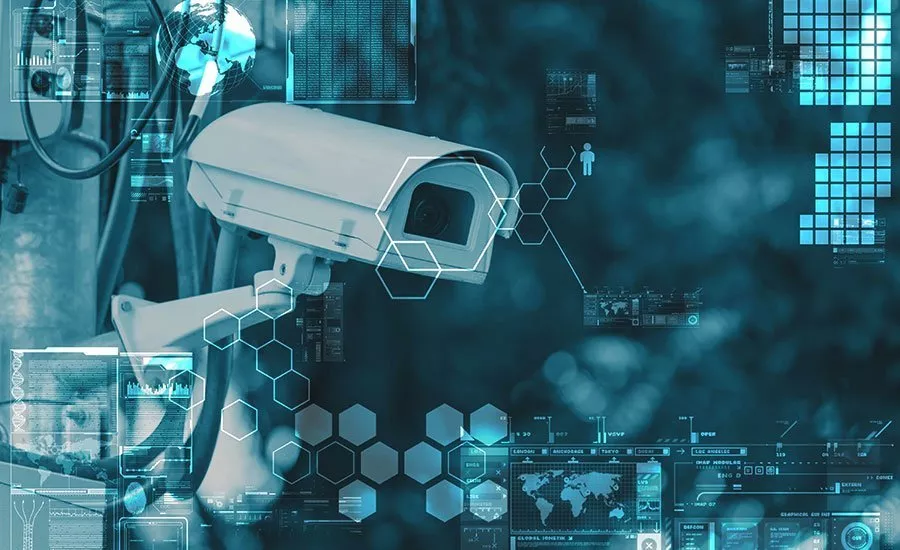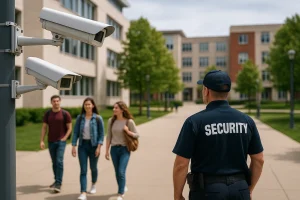Key Predictions For AI And Video Technology In Security: What To Expect
Here’s a short quiz you can take to see how much you really know about the rising use of AI in security systems. How aware are you of the transformations taking place with AI and video technology? Your legacy security system has worked pretty well for years. However, the security cameras posted at your manufacturing […]
By Catherine Shannon
September 27, 2024

Here’s a short quiz you can take to see how much you really know about the rising use of AI in security systems. How aware are you of the transformations taking place with AI and video technology?
Your legacy security system has worked pretty well for years. However, the security cameras posted at your manufacturing plant’s perimeters keep triggering false alerts because of the passing headlights from a nearby road. You solve this problem when you:
- A. Update to new AI technology in your security system—achieving visual intelligence, not merely video surveillance. A smart system can identify differences between animals, weather, cars, or actual intruders. This allows you to optimize your security personnel for multiple safety goals, not just false alarms. You might even save money by deploying a “leaner” team of remote monitors that can watch several locations or larger areas.
- B. Leave your security system alone and just have your security personnel respond to every one of the alerts that the motion sensors generate anyway, despite 99% of the alerts being false (better to be safe than sorry!).
- C. Keep your security system as is and merely tweak the cameras so they don’t face the road (even though that leaves a vulnerable gap in your security field of view).
(The correct answer is A).
Your retail store cameras are using AI video analytics in security; the cameras analyze customer behavior patterns. The system spots a person in your mall store that is wandering back and forth in a manner that looks suspicious. Your security team should:
- A. Ignore the behavior unless the person runs for the door, knocking other customers aside and dropping handfuls of products everywhere.
- B. Acknowledge that the video technology for security is using video analytics to recognize that a person is deviating from normal customer movements. But it may not necessarily be someone trying to steal, but someone who is confused or unable to find a product. You need a human-in-the-loop (HITL) manual review. You should dispatch an employee to provide some customer service that might close a sale AND potentially boost customer loyalty.
- C. Focus on the individual’s race or gender, prioritizing their face rather than just common behavior patterns. (Who cares about questions over bias or privacy- company management wants to fight shrinkage?)
(The correct answer is B).
Your company has customers in many different time zones and countries and has a strong customer-centric commitment. How do you best meet this goal?
- A. Your business has always offered after-hour phone voicemail with information about when the business resumes operations. Messages helpfully state holiday inclusions and weekend closures.
- B. Your company employs 24/7 live customer service reps. You want to put the customer first, even though your ROI with trained (costly) 24/7 reps is not optimum. This is because a large portion of your customer service calls simply involve basic questions (e.g., booking appointments, obtaining products, getting account balances, or directions).
- C. You let AI transform your customer service to 24/7/365 availability. AI chatbots and virtual agents work all-hours to handle the common customer queries, seamlessly handing off more complex questions to your human reps. AI also has a multilingual advantage for your global customer base. Your business becomes more efficient, scalable, and offers round-the-clock and year-round support.
(The correct answer is C).
With the rise of AI applications in all areas, criminals are also using AI. What are some of these cybercriminal applications of AI known as CaaS (Cybercrime as a Service)?
- A. Distributed Denial of Service (DDoS): Attackers can actually rent DDoS services to flood a website or service with traffic, disrupt a business, demand ransom, or derail competitors.
- Phishing kits- Conveniently designed for technology-challenged criminals, these premade phishing kits are sold to create fake websites or emails. The kits are used to steal information or spread malware.
- Ransomware as a Service (RaaS): RaaS is a model where criminal providers sell ready-made ransomware kits to their customers to deploy ransomware extortion for payouts. (Of course the provider gets a percentage of whatever extortion their customer gets!) Additionally, deepfake videos can be fabricated to show a company or executive of a company engaging in illegal or compromising activities. By threatening to release this deepfake video, the criminals extort the victim for money or data.Victims would rather pay than face reputation damage, embarrassment, or possible financial losses.
(A, B & C are ALL correct! Unfortunately [CaaS] Cybercrime as a Service is here to stay ).
So this quiz highlights how AI and video technology are truly transforming the security industry, moving it beyond the outdated legacy security systems of the past. Imagine the business applications you can utilize with these AI-enhanced video systems that can now:
- Analyze data in real-time.
- Identify and classify (objects, faces, or vehicles in video feeds).
- Detect anomalies (like a person loitering in a restricted area or a vehicle moving against traffic).
- Monitor crowd movements or unusual behaviors (safety/access issues for crowd events).
- Predict threats/suspicious activities before they occur.
- Forecast future security needs or risks (trend analysis).
- Do enhanced searches of videos (looking for specific events or objects).
- Give instant notifications (e.g., unauthorized access to your warehouse).
- Trigger responses (e.g., locking doors, operating signal lights based on traffic situations).
- Enhance video quality (by reducing noise or improving resolution to identify details or faces).
- Manage inventory, stock reordering, or improve store layouts for the retail industry.
- Integrate with (Internet of Things) IoT security devices (e.g., manage smart home thermostats or lights, do predictive maintenance schedules or quality control for industry equipment, navigate autonomous vehicles or establish fleet management, control traffic or energy/light usage for smart cities, remotely monitor health trackers for healthcare providers, analyze data for agricultural precision farming or livestock monitoring).
New opportunities within the security industry as the result of AI and transformed video technology are numerous. Experts say that AI won’t take jobs away, but people who know and use AI will take jobs from those who don’t. Proactive employers and businesses see the future of video surveillance and are upskilling to AI.
AI is creating expanded opportunities in various business sectors with:
- Adoption of AI-Powered Video Analytics: Software engineers are applying instant alerts in systems, reducing response time for security teams.
- “Edge” AI in Video Surveillance: Technologists adapt real-time surveillance features rather than use centralized data processing.
- AI-Driven Video Surveillance as a Service (VSaaS): Those offering cloud-based services will lower costs for companies, offer business scalability, manage analytics, data storage, etc.
- Context-Aware Surveillance Systems: Personnel can apply smarter AI that differentiates between harmless and threatening activities (for instance, distinguish between a jogger or a person fleeing a crime scene).
- AI Transformation of Drones and Robotics: Builders of drones and robotics are using them to fine-tune security systems—to secure large areas or coordinate during emergencies.
- Improved Access Controls: Specialists in biometric systems apply facial, fingerprint, or voice recognition as legal frameworks are established.
- Development of Privacy-Centric AI: Programmers use tools like automatic redaction of personal identifiers like faces or license plates from videos for a need-to-know basis.
- AI Ethics Specialists: specialists are overseeing the development of rules and transparency for video data collection, processing, and storage.
- Deepfake Detection: Skilled personnel can harness detection and authentication tools—crucial for national security, protection from misinformation, digital fraud, and legal frameworks for crimes or victim recourse.
- Forensic Video Analytics: Analysts interpret relevant video data in crime-solving, event reconstruction, identification of suspects, or as court evidence.
- Growth of Security Integrators and AI Applications: Professionals design, install, or manage complex security systems, integrate AI technologies, alarm systems, or cybersecurity solutions for companies.
This article has explored some key predictions for video analytics, the expanded role of video technology, and the many impacts of AI on security integrators. AI is opening up new opportunities and challenges for the security industry, making systems smarter and more responsive. However, with these transformations comes the tension of balancing security with privacy and legal concerns.
Related Posts
Startup
As long as there has been war, there has been a history of mercenaries- soldiers for hire that are paid to fight for a foreign army. Mercenary history is filled with stories of freelance warriors that impacted kingdoms and countries.\ Some historical mercenaries include: So exactly what is a mercenary soldier? The dictionary defines them […]
By Catherine Shannon
June 21, 2024
Security Guards
I really enjoy doing dead-end work for my unhelpful bosses, making no real money at it, and never getting ahead…” Said no one ever. You are someone that has long dreamed of running your own security guard company. You know you can do security work better than what you’ve seen out there- doing things your […]
By David
March 30, 2025
Business Growth
Learn how to cultivate long-lasting customer relationships in the safety patrol industry. Find out how to create a trustworthy environment, improve communication, and deliver first-rate service to win the trust and loyalty of your customers.
By David Kerolles
July 1, 2023





